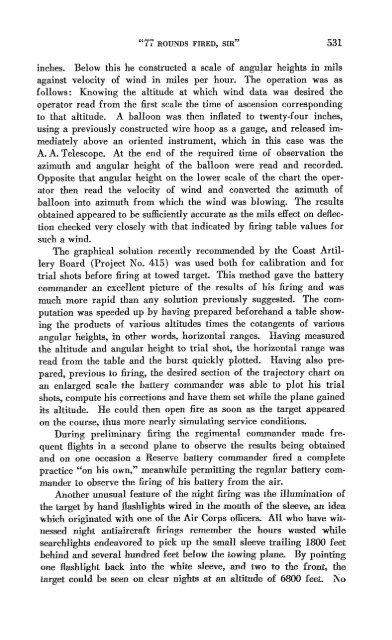COAST ARTILLERY, JOURNAL - Air Defense Artillery
COAST ARTILLERY, JOURNAL - Air Defense Artillery
COAST ARTILLERY, JOURNAL - Air Defense Artillery
Create successful ePaper yourself
Turn your PDF publications into a flip-book with our unique Google optimized e-Paper software.
"77 ROUNDS FIRED, SIR" 531<br />
inches. Below this he constructed a scale of angular heights in mils<br />
against velocity of wind in miles per hour. The operation was as<br />
follows: Knowing the altitude at which wind data was desired the<br />
operator read from the first scale the time of ascension corresponding<br />
to that altitude. A balloon was then inflated to twenty-four inches,<br />
using a previously constructed wire hoop as a gauge, and released immediately<br />
above an oriented instrument, which in this case was the<br />
A. A. Telescope. At the end of the required time of observation the<br />
azimuth and angular height of the balloon were read and recorded.<br />
Opposite that angular height on the lower scale of the chart the operator<br />
then read the velocity of wind and converted the azimuth of<br />
balloon into azimuth from which the wind was blowing. The results<br />
obtained appeared to he sufficientlyaccurate as the mils effect on deflection<br />
checked very closely with that indicated by firing table values for<br />
such a wind.<br />
The graphical solution recently recommended by the Coast <strong>Artillery</strong><br />
Board (Project No. 415) was used both for calibration and for<br />
trial shots before firing at towed target. This method gave the hattery<br />
commander an excellent picture of the results of his firing and was<br />
much more rapid than any solution previously suggested. The computation<br />
was speeded up by having prepared beforehand a table showing<br />
the products of various altitudes times the cotangents of various<br />
angular heights, in other words, horizontal ranges. Having measured<br />
the altitude and angular height to trial shot, the horizontal range was<br />
read from the tahle and the burst quickly plotted. Having also prepared,<br />
previous to firing, the desired section of the trajectory chart on<br />
an enlarged scale the battery commander was able to plot his trial<br />
shots, compute his corrections and have them set while the plane gained<br />
its altitude. He could then open fire as soon as the target appeared<br />
on the course, thus more nearly simulating service conditions.<br />
During preHminary firing the regimental commander made frequent<br />
flights in a second plane to ohserve the results heing ohtained<br />
and on one occasion a Reserve battery commander fired a complete<br />
practice "on his own," meanwhile permitting the regular battery commander<br />
to observe the firing of his battery from the air.<br />
Another unusual feature of the night firing was the illumination of<br />
the target by hand flashlights wired in the mouth of the sleeve, an idea<br />
which originated with one of the <strong>Air</strong> Corps officers. All who have witnessed<br />
night antiaircraft firings remember the hours wasted while<br />
searchlights endeavored to pick up the small sleeve trailing 1800 feet<br />
behind and several hundred feet below the towing plane. By pointing<br />
one flashlight back into the white sleeve, and two to the front, the<br />
target could be seen on clear nights at an altitude of 6800 feet. 1\0
















